This is something very special for those who have the passion and desire to see the very best the planet has to offer. And it helps if you love to drive and capture memories.
You may have heard a new term recently, “cramming”. Nothing to do with Uni exams. It’s about the need to see and do the best of life with the remaining days you have left on this planet. It’s a baby boomer thing. Funny… having had my life change dramatically when I was just 12 years old, that desire to ‘cram’ has always been with me. Every day could be your last… because one day it will be.
So, this crazy trip might just fit the bill for those who share our passion to make the most of every day!
Hiding in the southwest of the USA is The Grand Circle. It comprises a circular route of a week or two (two is less rushed) around the Colorado Plateau (Colorado, Utah, Nevada, Arizona, and New Mexico) with the most spectacular sights and fabulous roads… any time of year.
My wife Aileen and I have visited just now for the sixth time. Must be good!

As you can see from the attached map, there is a core set of sights with a bunch of add on places. All fabulous. Click here for a more detailed Google map version.
Where to start?
It’s a circle so you can start and finish anywhere. You can start in Las Vegas, Salt Lake City or Denver. These points are easily reached by cheap flights. You can also drive from Los Angeles (perhaps via Death Valley… don’t let the name put you off), San Francisco (via Lake Tahoe or the extraordinary Yosemite) or Denver (along the i70 past Vail and even Aspen… fabulous year-round but stunning in Autumn).
1. Start & End in Las Vegas
For this article, I am presuming a Las Vegas start. For us, the least time in Vegas the better. Hey, we liked it the first few times!
On the way from Vegas, you get to drive past the massive Hoover Dam (1936) and Lake Mead (a bit short of water in recent years) on the Colorado river. Breathtaking construction that became the key to water security for California.
You can even follow the remaining and most preserved sections of historic Route 66 between Las Vegas and The Grand Canyon. The unique town of Oatman is a sight to behold. Just like the old west with saloons and donkeys everywhere. Cute.
2. Grand Canyon
First main stop is the Grand Canyon (South Rim).
The Colorado Plateau that underpins the Grand Circle was once a seabed. The shift in tectonic plates pushed this whole area up way into the sky. The Rockies are the highest bits, the ‘lower’ plateau is as high as Mt Buller, and the deeply eroded rivers are way-way down low. At the Grand Canyon, the Colorado river is a mile lower than where you are standing. Breathtaking.

The Grand Canyon is one of the Seven Natural Wonders of the World and is well worth both dawn and dusk photos. Easier to do sunrise and sunset photos in winter when days are shorter, and the snowcapped distant ranges only add to the beauty.
The Grand Canyon deserves at least a full day (and two nights). It is truly memorable.
3. Page
Main stop number two… Page. You have probably never heard of it.
Situated 2 hours’ drive upstream on the Colorado, Page offers two special treats. The first is Horseshoe Bend where the Colorado winds its way around a huge visible twist in the canyon 1000 feet below you.
Dawn is excellent as you can see in my iPhone snap.
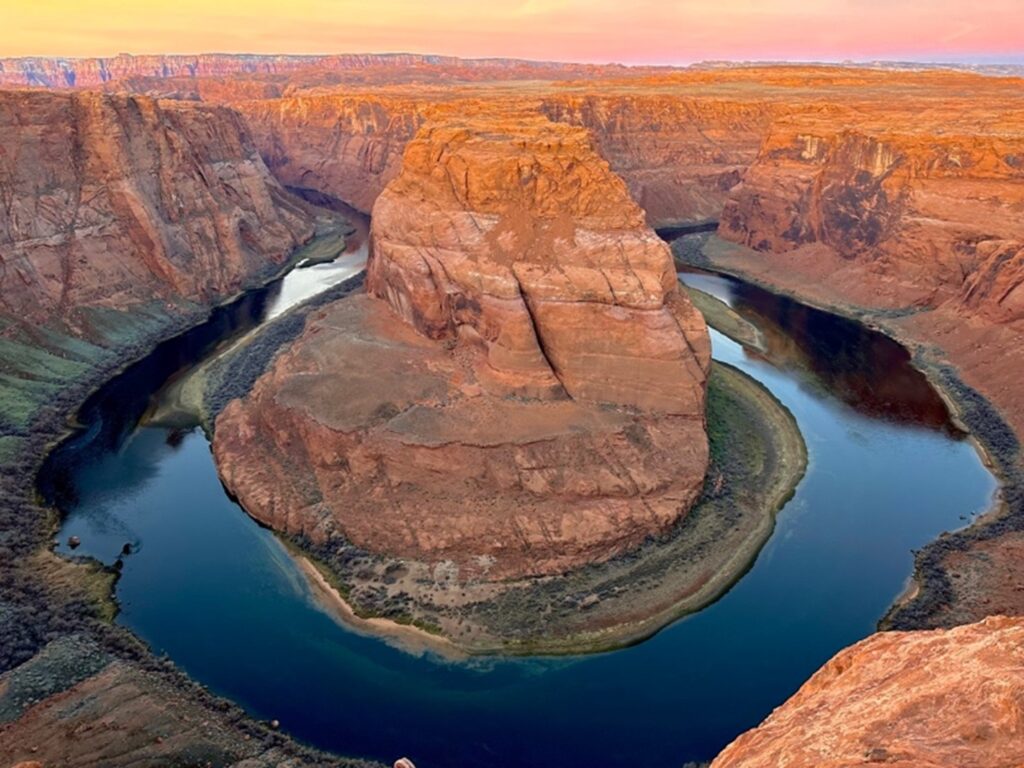
The second treat at Page is Antelope Canyon. It is a sacred place for the Navajo people so you can only enter with an official guide. You should book this in advance on the internet. Or turn up early at the tour shops in Page.

Antelope canyon is the best known and possibly most awe inspiring of the many Slot Canyons in the region. Most people visit the Upper Canyon for its falling sand that creates patterns for amazing photographs. Naturally. we have several such photos on our walls at home.
The Australian photographer Peter Lik achieved the highest price ever ($6.5 USD million) for his black and white snap of the falling sand in the Canyon. He called his ‘the Phantom’.
4. Monument Valley
Next main stop… Monument Valley.
Situated on a Navajo reservation, there is only one place to stay, The View. Not expensive but you need to book in advance. No alcohol allowed. Still must wear masks in public areas.
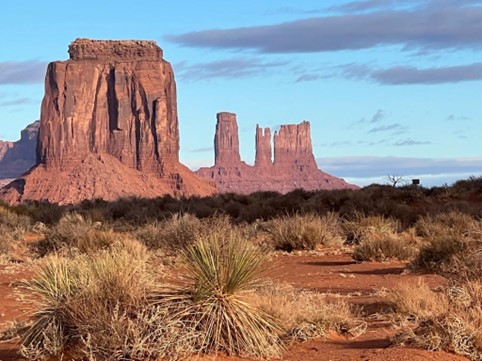
Starting at the hotel, there is a short drive down through the awesome towers formed by erosion over millions of years. The iconic area was used by John Ford in his many Western movies with his star John Wayne. Both dawn and dusk are amazing. And you can get fabulous shots from your balcony.
Seriously… you don’t even have to leave your room to get the photo of a lifetime.
This dirt road circuit of perhaps 6 miles takes visitors though extraordinary towers, buttes, and mesas. Great little drive. It opens at 8.00 am. and closes at 3.00 pm. If you miss the afternoon, be sure to do it the next morning. Or do both.
Five miles further north on the road, past many more roadside vendors peddling jewelry and handmade blankets, is another famous movie scene from Thelma and Louise (where the policeman stops them at night and Louise shoots a hole in the boot that the policeman is locked in) and Forest Gump (where Forest says ‘I think I will go home now’).
You won’t miss it… to our horror this location has now been named Forest Gump Point!
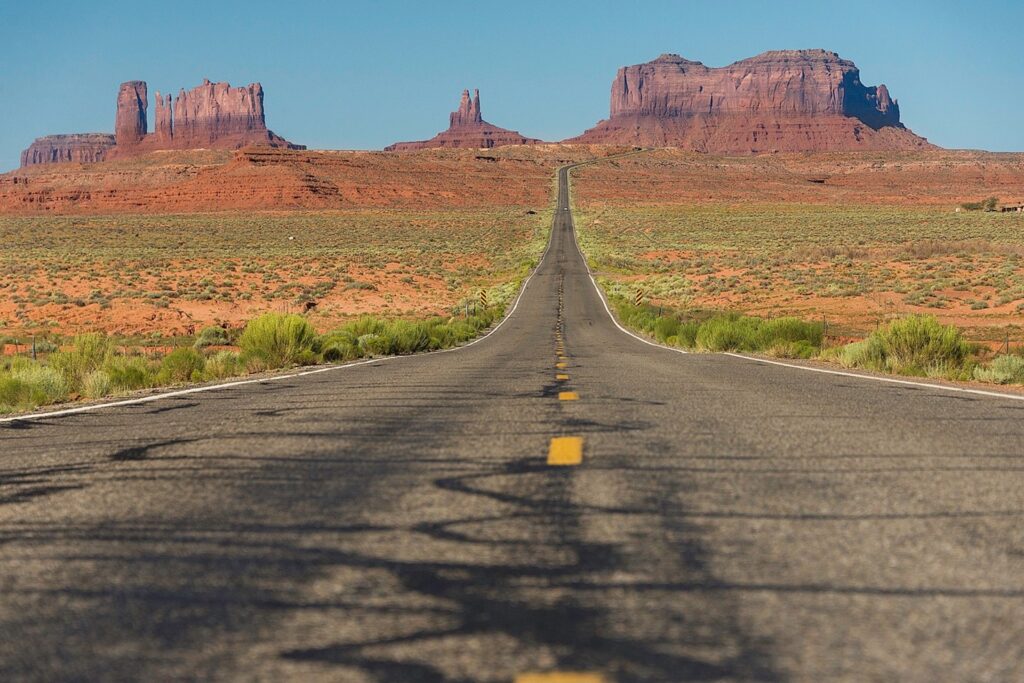
But this classic photo down the long road is precious.
5. Moab
Next main stop is Moab.
Before that, you are travelling past two interesting deviations. The first is the Four Corner monument. As the name suggests, you can photograph yourself with your feet and hands in four states. A bit corny and you are unlikely to do it again.
The second deviation is a bit more interesting. Mesa Verde is a cliff side village of the pueblo people. It dates back to the 13th Century and is remarkably intact. You can visit, get up close and check out how they built an entire village into the cliffs. Cool!
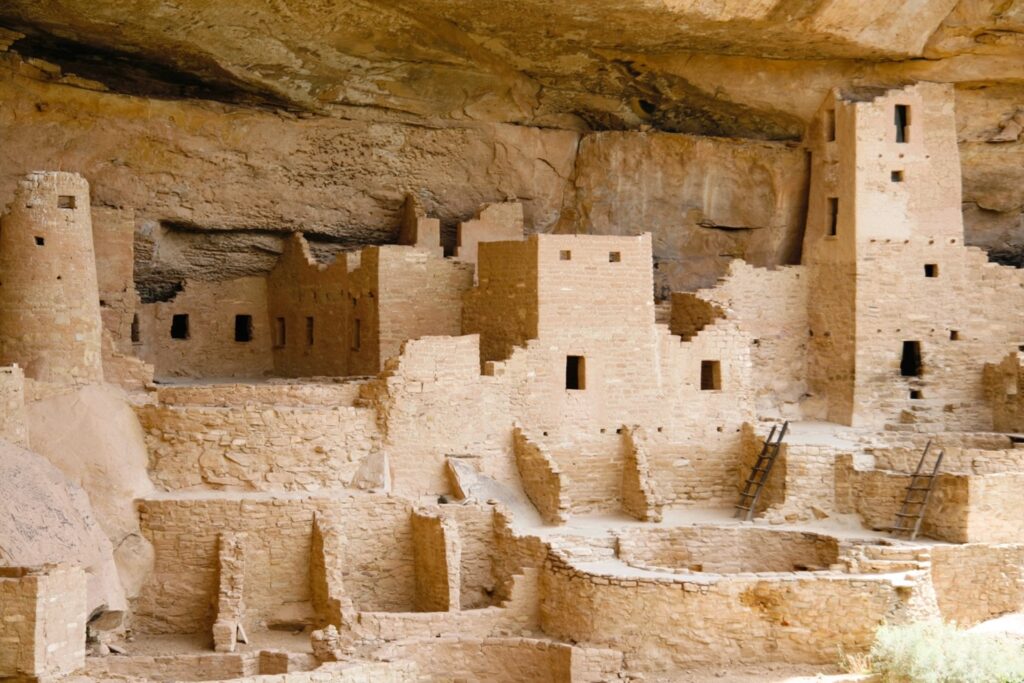
TIP: most places you visit will be National Parks. Buy a seasonal pass and it’s very economical. About $USD 80 for the car and it lasts a year. For your next visit?
Okay Moab. The hub of so much wonder. First is Arches National Park… right next to Moab.
More erosion, different outcome. In a smallish park, there are literally hundreds of giant arches left behind in the sand and red rock. What a great place to visit. A great drive that depending on your desire to hike, can take at least a day to explore.
Our favourite Moab adventure is Canyonlands.
The entrance is about half an hour’s drive from Moab and this one is amazing. It is a long peninsular in the sky. Colorado River one side and Green River the other. Massive drops either edge. Views across the plain below, or the rivers carved into that plain, or the snowcapped Rockies in the distance. All of these vistas can be seen through the famous Mesa Arch, best captured at dawn when the rising sun lights up the inside of the huge arch.

Of course, it is easier to do sunset and sunrise in the winter. To capture our photo like the one above took five visits. In Summer, the sun sets late (the best bits are the red colours after the sun sets) and it’s an hour’s drive back to Moab. The best colours are also before the sun rises. Add the one hours’ drive from Moab each way and in summer that represents maybe three hours sleep of you want both sunrise and sunset!.
Should also mention the Dinosaur National Monument next to Moab. Great drive and you need only explore maybe ten or so miles up the canyon. You won’t see any dinosaurs, but the rock cliffs are fabulous.
6. Torrey
Next stop…. Torrey.
A little town is at the center of the Capital Reef. Reasonable choice of motels and a couple of ok eating places. And center of amazing short drives and interesting walks around the area.
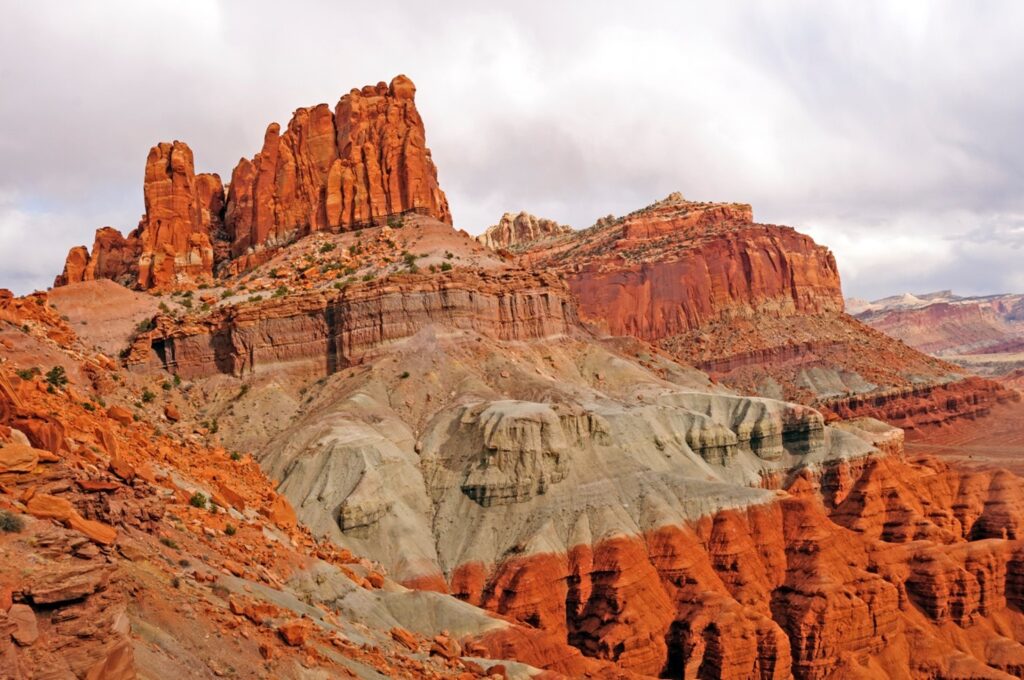
And the start of Byway 12… one of the most well-known USA Byways.
The USA has the most amazing and historic national parks and has built well maintained and fun roads through them all.
TIP: There is a National Geographic book called USA Byways that can be purchased online. Full of more info on this loop and so many other national parks. It is our go-to guide for the most fabulous drives throughout the USA.
7. Bryce Canyon
Next stop: Bryce Canyon and the Hoodoos.
More weird geology! This time the hoodoos (‘forests’ of them) stand a hundred feet high from the valley floor like the bristles of a brush. In Winter, the tops are covered in snow like icing on a cake. Magic all year round. You look down on them from various cliff edges.
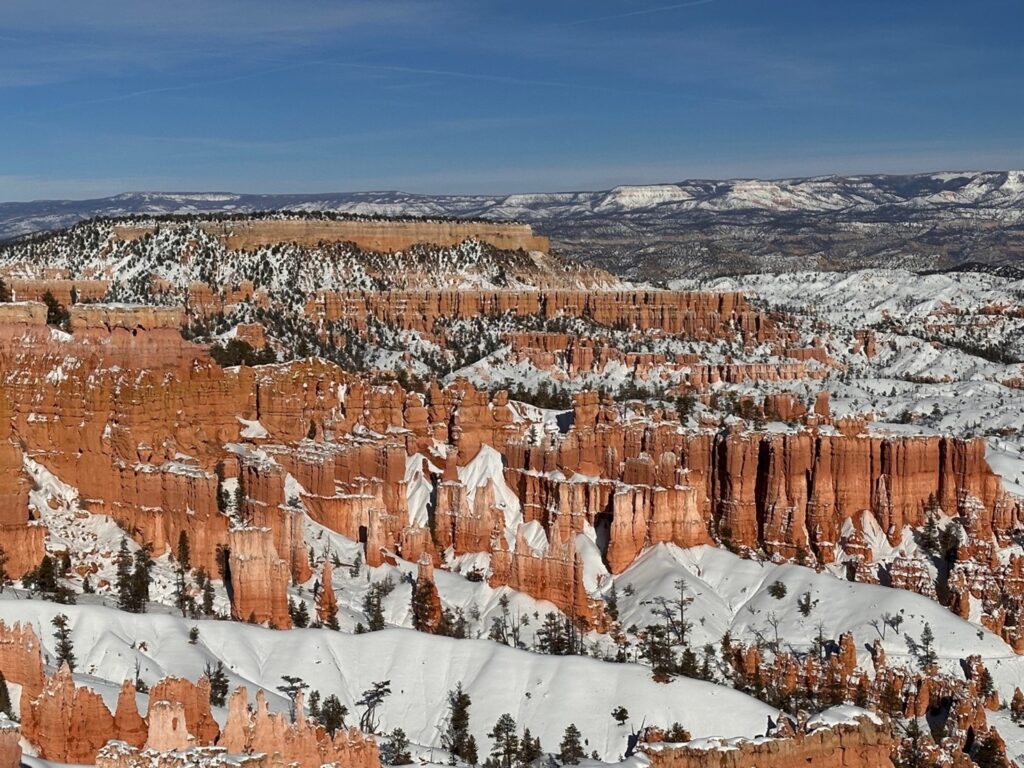
Stay the night if you want the dawn and dusk photos. In winter, you can buy lightweight crampons at the general store (for around $USD 35) that attach to your shoes that will give you better grip in icy conditions. That will enable you to venture down amongst the hoodoos.
The crampons are keepers! You never know when you might need to hike over ice again?
8. Zion National Park
Last stop… Zion
Just when you thought that this was as good as it gets… Zion National Park. Based around the little town of Springdale, the 6 mile drive up the Zion valley is priceless. As is the entry through the long tunnel.
If you are brave, there is also a walk up to Angles Landing (a tad scary and only open in Summer) or the knee deep walk up the Virgin River after the tourist path ends.
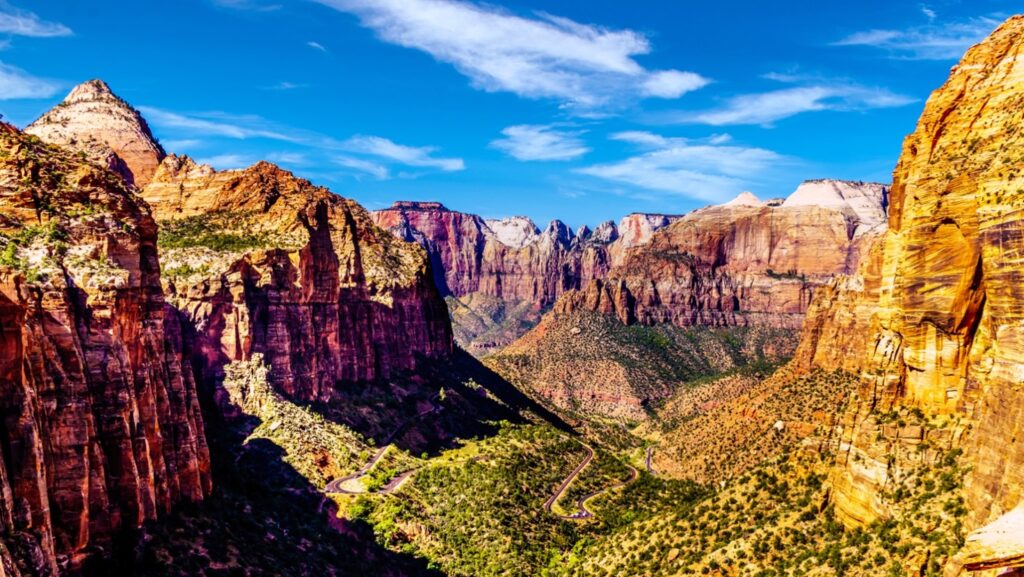
Nothing like canyon walls that rise so steeply that you need to strain your neck to see the tops. They are a long way up and are very colourful.
9. Further TIPS:
Car hire. If you travel in Winter, be sure to hire a 4 x 4 as the icy bits can be a bit slippery. Some parks (such as Yosemite) also require chains. You can buy these at a Napa Auto Parts store (in most regional towns) and if you don’t use them, they will buy them back. Car hire costs are less if you start and end in the same place. Easier with a circle drive.
Rental vehicles are not meant to be driven off road. Hmmm. Let me think about that for a second.
Accommodation. Surprisingly acceptable in all places. Everywhere in regional America too. Average cost is around $USD 100 to 120 per night. The odd place like Furnace Creek in Death Valley is expensive. Look for Hampton Inn, Wyndham, Best Western, Homewood Suites and La Quinta. Brand names are usually better.
Fast free internet is at every place, even where there is no phone coverage… which mostly only happens in remote drives.
Breaky is usually included too. Expect pleasant food like eggs, muffins, oats, and coffee. We avoid the waffle machine and the hickory and maple syrup sausages. American’s love their sugar.
Food. Supermarkets are good everywhere. Amongst an ocean of dreadful take away offerings in the towns, supermarkets stand out for fresh, often organic foods, which provide lots of goodies to eat on the road. The contrast between a town’s fast food and the supermarket’s fresh vegetables, is strange.
The larger towns have the better chain restaurants. Look for Outback (don’t laugh, their USDA prime steaks are as good as you get back home), Red Lobster, Ruth Chirs’s (upmarket steak) and Sizzler (yes, the 90’s phenomenon in Australia is known as a premium brand in the USA). You will be pleasantly surprised by all of these.
Outback is a rip off (appropriation) of Aussie culture is a garish way. You can’t buy anything that originates from Australia, including their worldwide wine list. We still go there!
While at breaky… pinch a couple of bits of fruit and a couple of boiled eggs to put with your other goodies, into a chiller bag. That way you can avoid the rubbish lunch offerings along the way.
Restaurants in remote towns will be Mexican, Burger or maybe Chinese or (maybe) Italian. Otherwise, there is a myriad of the usual fast-food offerings everywhere. Buy lots of water to carry in the car, especially in summer.
Mobile coverage. A bit scant at times but you can download Google Maps for specific regions. When you plot a multi stop day, send yourself the Google directions so it is quick and easy to recover the directions should you lose them.
Playlists. Hmmm. If you don’t love Country and Western, best to top up your playlists and make sure they are (actually) downloaded. You will need your connector cable for the car. Most cars have Apple car play so the cable will connect the car to your phone. Remember that many cars are switching to USB-C connection so be ready for this as well as the older USB-2 style connection.
American television. Cable offering are at every hotel. But don’t expect your favourite programs… and they have lots and lots of annoying repetitive advertisements across hundreds of rubbish channels.
A better choice is to buy an Apple Lightning to HDMI adapter and bring you own HDMI cable (you will find that HDMI cable in your cupboard with the big box of cables). That way, you can watch your own Netflix, Stan, Disney, Paramount and Prime. Foxtel and Binge don’t work outside of Australia (test these connections before you leave home).
Or bring a book! There is not much to do in some of these towns at night. Especially noticeable as food service is so ridiculously fast. A two-course meal is usually over in 45 minutes. Annoyingly, both courses are often served at once! With an apology. For this you will tip 20%.
Masks. Yes, bring them with you. Several First Nations environments require masks. A little annoying but it reminds us of where we were just a few years ago.
10. Summary.
That’s it. There is much, much more that you will find along the way. More slots, more deserts, more buttes & mesas, more rivers and canyons, and more amazing roads that you will love to drive.
Amazing what geology has created. Massive structures thanks to those moving plates. Extraordinary shapes and contrasts thanks to millions of years of water, ice and wind reshaping rivers, mountains, gorges, passes and plateaus.
So accessible and easy to visit. Great roads and very acceptable amenities.
Hugely rewarding experience. Doesn’t get much better. There are other places but that’s for another article.
I watched Peter Brock on many occasions patiently signing hats, t-shirts and even bodies with the same message. “Live Life”. I wonder if he ever had the pleasure of driving the Grand Circle.
What a way to do a bit of Cramming? If you want some extra tips, just pick up the phone! Happy to help.
Chris Alp
